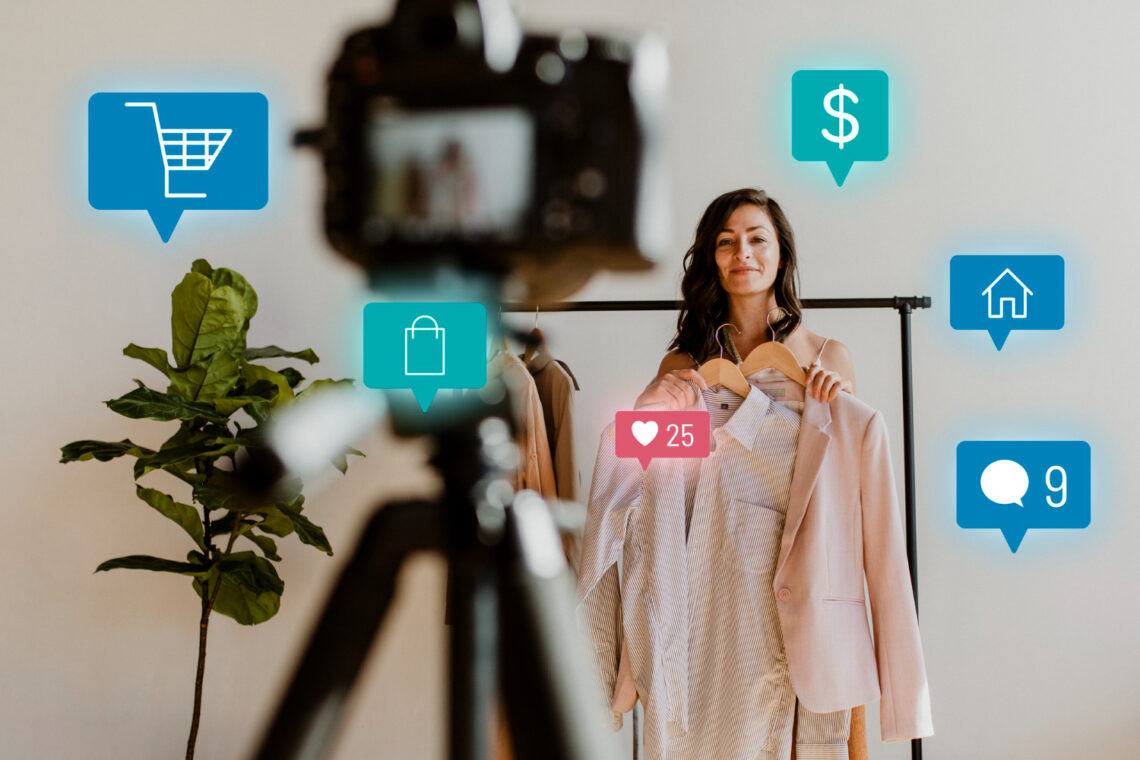Ten years ago, influencer marketing mainly involved celebrities and a handful of committed bloggers. Fast forward to today, and we have a plethora of social media influencers saturating the scene. These influencers come in various sizes but have a significant impact.
They’ve built close-knit communities, which means they have genuine connections with their followers. This results in increased levels of trust and engagement. However, partnering with these digital creators and influencers can be a complex journey for brands. Don’t worry; we’re here to guide you through it.
Keep reading to discover our advice on crafting a successful influencer marketing plan, the common pitfalls to avoid, and much more.
What is Influencer Marketing?

Influencer marketing is a smart way to advertise products or services on social media. It involves getting support and mentions from influencers, who are people with a big and loyal group of followers in a specific area. This works well because these influencers have earned much trust from their followers.
When they recommend something, it’s like giving your brand a big thumbs up in front of potential customers. It’s like saying, “Hey, this is good; you can trust it.” Teaming up with a mega-popular influencer with millions of followers might seem fantastic, but it’s not always the right choice for your brand. You see, social media influencers come in different flavors.
Some have huge followings that cover a wide range of people, while others have smaller but more focused and engaged groups of followers. Understanding what each type of influencer can bring in terms of how many people they can reach, the variety of folks they can connect with, the cost of collaborating with them, and how engaged their followers are is crucial for picking the perfect influencers for your brand.
So, let’s dive deeper into the world of influencers and explore the different types out there.
Who are Mega Influencers?
Mega or celebrity influencers are the big shots of the influencer world. They have a whopping 1 million or more followers and often include famous actors, musicians, sports stars, and other well-known public figures. Their fame lets them connect with a wide range of people, which makes them perfect for spreading the word about big brands. Think about people like Selena Gomez or Cristiano Ronaldo.
Mega influencers can get your brand a ton of attention, but there’s a catch: they can be super expensive to work with. Also, because their audience is usually quite diverse, their followers might not be as engaged as those of smaller, more specialized influencers.
Now, here are the kinds of businesses that could benefit from teaming up with mega influencers:
- Really big companies with a hefty budget.
- Brands that want to reach a big audience with different people.
- Luxury or high-end brands aim to create an exclusive image.
Who are Macro-Influencers?
Macro-influencers are like the seasoned pros of the influencer world, typically having followers ranging from 100,000 to 1 million. They’re big names in their niches. These influencers have built their reputation by consistently creating content and engaging with their audience over time. Now, they’re considered experts in what they do.
Working with macro-influencers is a savvy move for your brand, especially considering influencer marketing agencies in India. Macro-influencers offer a more focused approach than celebrities because their followers usually share common interests. If you team up with macro-influencers, you can reach many people interested in your niche, but it might still cost you a bit, depending on your budget.
This collaboration can be a strategic step in your marketing journey, especially when tapping into the expertise of influencer marketing agencies in India to connect with the right macro-influencers for your campaign.
Now, here are some examples of the kinds of businesses that could benefit from working with macro-influencers:
- Startups that want to get noticed, grow, and build credibility quickly.
- Nonprofit organizations are trying to raise funds and awareness for their causes.
- Hotels and airlines target a specific but large audience.
Who are Micro-Influencers?
Micro-influencers are the new influencers in influencer marketing, usually with followers ranging from 10,000 to 100,000. They shine brightly on specific platforms like Instagram, YouTube, and TikTok. What makes micro-influencers special is their ability to connect with a smaller but super-engaged audience. They create creative content, offer relatable advice, and have real conversations with their followers.

The cool thing is they won’t break your marketing budget. They’re more affordable than the bigger influencers. But don’t be fooled by their size – they’re highly effective. According to experts, Micro-influencers are a good choice for influencer marketing due to cost, authenticity, engagement, multi-market reach, and niche market.
Who are Nano-Influencers?
Nano-influencers are the tiniest players in the influencer game, usually having less than 10,000 followers. But don’t underestimate them! They make up for their small following with strong connections to their audience.
They do this by being real and engaging. Even though they don’t have a big reach, nano-influencers are fantastic for businesses that want to target very specific groups of people without spending a ton of money.
That’s why more brands are interested in working with nano-influencers in 2023. Because nano-influencers work on a small scale, they can focus on each partnership. This means they can create just the right content for your brand and build personal relationships within niche communities.
Here are some examples of the kinds of businesses that could benefit from teaming up with nano-influencers:
- Local businesses that want to connect with specific communities, cities, or regions.
- Small businesses with tight budgets that want to run budget-friendly campaigns.
- Artisan, home-based, or specialty food businesses are trying to reach people interested in their unique products.
What are the reasons for utilizing influencer marketing?
56% of young Americans make purchases based on posts from people they follow. Let’s understand this in depth. Utilizing influencer marketing is driven by several compelling reasons backed by noteworthy statistics:
- Trust and Credibility: Influencers often enjoy high trust and credibility among their followers. When they endorse a product or service, it’s seen as a genuine recommendation, which can significantly influence consumer decisions.
- Targeted Reach: Influencers have specific niches or demographics they cater to. This means you can choose influencers whose followers closely match your target audience, ensuring your message reaches the right people.
- Authenticity: Influencers connect with their audience through authentic and relatable content. This authenticity can help your brand connect with consumers more personally.
- Engagement: Influencers often have highly engaged followers. This means that when they promote your brand, it’s more likely to result in meaningful interactions, comments, and shares.
- Content Creation: Influencers create engaging content tailored to their audience. This can give your brand a fresh perspective and creative materials for marketing campaigns.
Creating a five-step plan for an influencer marketing strategy
While Instagram is a famous platform for influencer marketing, it’s important to recognize that other emerging networks have their influencer communities. Platforms like TikTok, YouTube, and Snapchat have their unique sets of influencers who appeal to diverse demographics.

However, it’s crucial to understand that influencer marketing isn’t as simple as giving free products to anyone who asks or relying solely on your network.
Here are some valuable tips for crafting effective influencer marketing campaigns:
Define Your Goals and Objectives
- Identify Your Marketing Objectives: Start by pinpointing your brand’s marketing goals. Do you want to increase brand awareness, drive website traffic, boost sales, or engage with your audience on social media? Having specific objectives in mind will guide your entire strategy.
- Set Measurable KPIs: Once you’ve established your goals, regulate the key performance indicators (KPIs) that will help you track your progress. For instance, if you aim to increase sales, your KPI might be a specific percentage increase in monthly revenue.
Identify Your Target Audience
- Create Detailed Buyer Personas: Develop comprehensive buyer personas that outline the quality of your ideal customers. Consider demographic information (age, gender, location), psychographics (interests, values, and behaviors), and pain points. This understanding will guide your influencer selection and content creation.
- Platform and Content Preferences: Research the online platforms and content types your target audience prefers. Are they more active on Instagram, YouTube, or TikTok? Do they consume blog posts, videos, or live streams?
Find the Right Influencers
- Set Influencer Criteria: Define the specific criteria your influencers should meet. Consider factors such as follower count, engagement rate, niche expertise, and alignment with your brand’s values and messaging.
- Utilize Influencer Discovery Tools: Explore influencer discovery platforms and tools to help you identify potential influencers matching your criteria. These tools often provide valuable insights into an influencer’s audience and engagement metrics.
Develop a Collaboration Plan
- Communicate Expectations: Outline your campaign objectives, expectations, and brand guidelines to the chosen influencers. While sharing your goals is essential, be open to their creative input, as they know their audience best.
- Negotiate Terms and Compensation: Discuss compensation terms, whether it’s monetary payment, free products, or other incentives. Clarify deliverables, content creation expectations, and deadlines during negotiations.
- Formal Agreements: Draft formal influencer agreements or contracts that detail the responsibilities of both parties. Cover content ownership, payment schedules, exclusivity, and partnership disclosure.
Execute and Measure the Campaign
- Monitor Campaign Progress: Keep a close eye on the campaign as it unfolds. Ensure that influencers deliver content as agreed and engage with their posts and the audience’s comments.
- Analyze and Measure Results: After the campaign, assess its performance against the established KPIs. Examine reach, engagement (likes, comments, shares), website traffic generated, and conversion rates.
- Iterate and Improve: Use the insights provided by the campaign to refine your future influencer marketing strategies. Identify what worked well and what could be enhanced to improve your ROI continually.
How to track influencer marketing campaigns

Use UTM Parameters
Create custom UTM parameters for the campaign to track traffic and conversions from the influencer’s content. This will help you understand which influencers drive the most valuable traffic and conversions.
Track Engagement Metrics
Monitor key engagement metrics such as likes, comments, shares, and saves on the influencer’s posts. These metrics can help gauge interest and interaction with your campaign.
Monitor Website Traffic
Google Analytics tool helps to track the website traffic generated by the influencer’s content. You can set up specific UTM parameters for each influencer’s content to differentiate their impact on your site’s traffic.
Measure Conversions
If your campaign aims to drive sales or conversions, track the number of conversions attributed to the influencer campaign. E-commerce platforms often provide conversion tracking features.
Calculate ROI (Return on Investment)
To determine the campaign’s ROI, compare the cost of the influencer partnership with the revenue or value generated. Calculate ROI based on your campaign’s specific objectives (e.g., sales, brand awareness, engagement).
The Bottom Line
Influencer marketing has rapidly evolved and will likely continue to change in the coming years, yet the core process remains akin to conventional marketing campaigns. Research, budgeting, goal-setting, influencer selection, and ongoing evaluation are fundamental steps. Embracing these fundamentals while staying agile and adaptable is key to navigating the ever-shifting terrain of influencer marketing, ensuring successful campaigns and enduring brand growth.
FAQS
What is the primary goal of an influencer marketing strategy?
The primary goal of an influencer marketing strategy can vary but often includes objectives such as increasing brand awareness, driving product sales, enhancing engagement, or reaching a specific target audience.
How do you choose the right influencers for your campaign?
Influencer selection depends on your target audience, campaign goals, influencer authenticity, and brand alignment. Researching their content, audience demographics, and engagement rates is essential.
What role does authenticity play in influencer marketing success?
Authenticity is crucial as it builds trust with the audience. Authentic influencers who genuinely believe in and use your product or service can create more meaningful connections with their followers, leading to higher engagement and conversions.
How do you measure the success of an influencer marketing campaign?
Success can be driven through key performance indicators (KPIs) specific to your campaign objectives. Metrics like engagement rate, website traffic, conversion rates, and return on investment (ROI) are commonly used to gauge performance.




